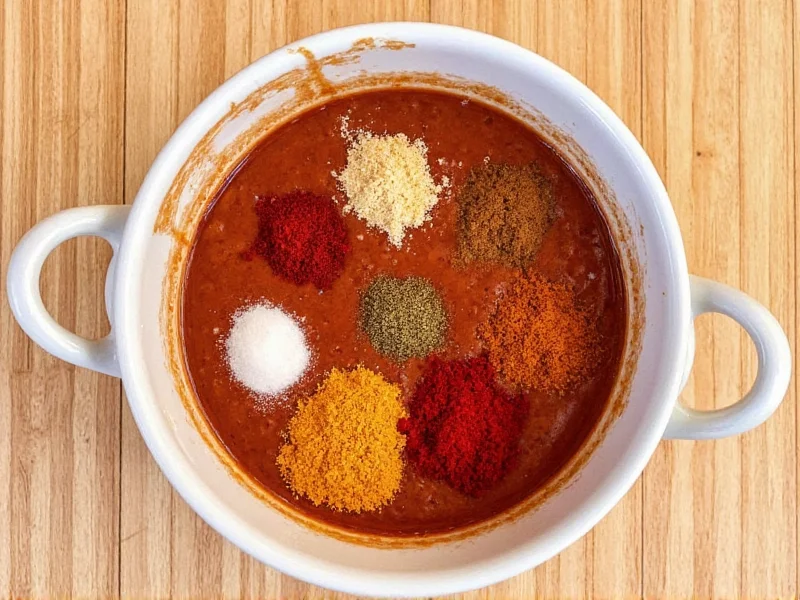Creating exceptional chili hinges on understanding how spices interact with meat, beans, and tomatoes. The right spice blend transforms simple ingredients into a complex, satisfying dish that warms from within. Whether you're making Texas-style beef chili or a vegetarian bean version, proper spice selection and timing make all the difference.
Essential Spices for Chili and Their Roles
Mastering chili requires knowing not just which spices to use, but why they work. Each spice contributes specific flavor notes that build the foundation of great chili:
| Spice | Flavor Profile | Standard Measurement (per lb of meat) | When to Add |
|---|---|---|---|
| Chili Powder | Earthy, slightly sweet, moderate heat | 2-3 tablespoons | With onions and garlic at beginning |
| Cumin | Warm, nutty, earthy depth | 1-2 tablespoons | With chili powder to bloom flavors |
| Smoked Paprika | Rich smokiness, subtle sweetness | 1 tablespoon | After toasting other spices |
| Garlic Powder | Pungent, savory backbone | 1 teaspoon | With dried spices before liquid |
| Dried Oregano | Herbal, slightly floral | 1 teaspoon | Midway through cooking |
Perfecting Your Spice Blend
Understanding how much cumin to put in chili prevents overwhelming other flavors. While cumin anchors traditional chili, exceeding 2 tablespoons per pound of meat creates bitterness. For authentic Texas chili without beans, increase chili powder to 4 tablespoons and add a single bay leaf during simmering.
When considering spices for authentic Texas chili, remember this regional specialty typically contains only meat, chilies, and minimal spices. Skip beans and tomatoes, focusing instead on ancho and guajillo chilies blended with cumin and garlic. Toast dried chilies before soaking to unlock deeper flavors.
Customizing Heat Levels
Tailoring spice intensity matters whether cooking for adults or children. For family-friendly chili, reduce cayenne to 1/8 teaspoon and add 1/2 teaspoon of cocoa powder to mellow heat while enhancing richness. This approach creates mild spices for chili for kids without sacrificing depth.
Those preferring extra heat should incorporate cayenne gradually, tasting between additions. For complex heat, combine cayenne with a pinch of crushed red pepper flakes and 1 minced jalapeño added with aromatics. Remember that when to add spices to chili affects heat perception—adding chilies early distributes heat evenly, while late additions create sharper spice bursts.
Advanced Flavor Enhancements
Professional chefs often include unexpected ingredients that elevate chili from good to extraordinary. A pinch of cinnamon (1/8 teaspoon) adds warmth without sweetness, while 1 teaspoon of instant espresso powder deepens meaty flavors. For spices that complement beef chili, try adding 1/2 teaspoon of coriander to brighten heavy flavors.
Understanding how to balance spices in chili requires tasting at multiple stages. If your chili tastes one-dimensional, add acidity with 1 tablespoon of apple cider vinegar. For flat flavors, incorporate 1/4 teaspoon of allspice to create complexity. Always adjust salt last, as other spices affect perceived saltiness.
Regional Variations Worth Trying
Different regions have distinct approaches to traditional chili spice blend composition:
- Texas Style: Focuses on meat and chili varieties with minimal spices—primarily cumin, garlic, and oregano
- Cincinnati Style: Includes Worcestershire sauce and a touch of cinnamon for sweetness
- New Mexico Style: Features roasted green chilies and minimal additional spices
- Midwest Style: Often includes tomatoes and a more robust spice profile with paprika
Common Spice Mistakes to Avoid
Many home cooks make critical errors when adding spices to chili. Never dump all spices into cold ingredients—always bloom dried spices in hot oil for 30 seconds to release essential oils. Avoid pre-mixed chili seasonings which often contain excessive salt; create your own blend for better control.
Don't add all spices at the beginning. Delicate herbs like oregano lose flavor during long simmers, so add them in the last 30 minutes. For optimal results in spice ratio for chili, maintain a 3:2:1 ratio of chili powder to cumin to paprika as your starting point, then adjust to taste.
Creating Your Own Chili Powder Blend
Store-bought chili powder varies significantly in quality and composition. For superior results, make your own homemade chili powder recipe by combining:
- 2 parts ancho chili powder
- 1 part guajillo chili powder
- 1/2 part cumin powder
- 1/4 part garlic powder
- 1/4 part onion powder
Store in an airtight container for up to 6 months. Freshly blended spices provide noticeably brighter flavor than pre-mixed versions that lose potency over time.
Storing and Reusing Spice Blends
Preserve your custom chili spice mix by storing it in a dark glass jar away from heat sources. Properly stored, your blend maintains peak flavor for 4-6 months. For meal prep efficiency, portion your traditional chili spice blend into single-use packets labeled with measurements—simply dump and go when cooking.











 浙公网安备
33010002000092号
浙公网安备
33010002000092号 浙B2-20120091-4
浙B2-20120091-4